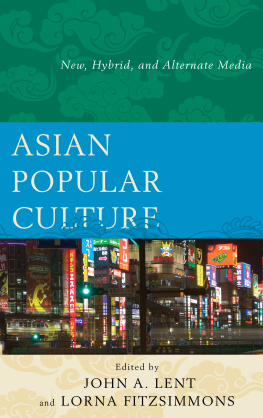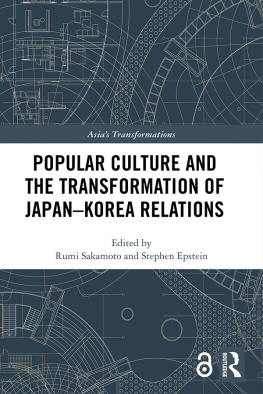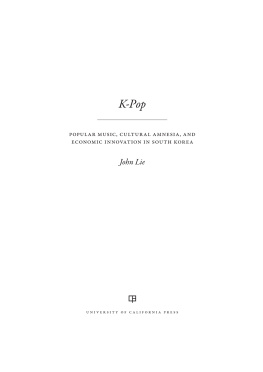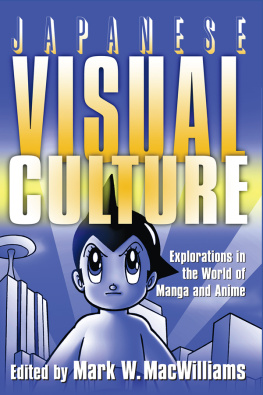Introduction
Asian Popular Culture: New, Hybrid, and Alternate Media is an interdisciplinary study of popular culture practices in Asia, including regional and national studies (Japan, China, South Korea, and Australia). It explores the evolution and intersection of popular forms and explicates their changing cultural meanings in historical and contemporary contexts. At its core is the issue of the roles popular culture plays in the construction of national and regional identity.
When the senior author of this book joined the faculty of a large university on the East coast of the United States in 1974, his officemate was Marshall Fishwick, one of the earliest scholars of popular culture. They were both in the journalism department, one of a very few places in the United States to house a popular culture course. Though it enrolled a roomful of students each semester, the course drew whispered wisecracks from some faculty members who questioned its presence in a school of communications. They picked up on criticisms made by some congressional report or other that ridiculed some obscure or trivial popular culture topic that was part of a funded research study. They and most others did not see the close connections between popular culture and mass communications.
As the years passed, it became clearer that, in many instances, the topics that mass communications researchers dealt with were actually popular culture forms (e.g., television, radio, cinema, advertising, Internet), and the concepts behind their work often fit popular culture as well. Some recent terms common to both fields of study are those of convergence, globalization, glocalization, and hybridity, all covered to varying degrees in this book. Because they fit into the theoretical bases of these chapters, the terms are defined here, which has been a difficult task in that they are not always mutually exclusive and their meanings vary among researchers and disciplines.
Convergence is the coming together of computing, telecommunications, mass media (and popular culture) in a digital environment, what the French termed tlmatique decades before. Technically, convergence occurs as conventional media are converted into digital media form. Economic convergence refers to the merging of print and electronic media companies with those of the Internet and telecommunications, leading to near-monopoly consolidation, and cultural convergence results from the spreading of media content, usually from Western countries, in what is also called globalizationglobal interconnectivity through new information technology. This is an instance where the differences between two conceptsconvergence and globalizationseem slight, though those theorists who pontificate about one or the other notion would strongly disagree.
Functions ascribed to globalization, such as the spread of liberal democracy, economic capitalism, modernity of lifestyle, and a consumer culture, have often been challenged as leading to cultural homogenization and imperialism, global Americanization, and the loss of national identities.
All three types of convergence are highly visible throughout Asia, with an online presence for many print media; the existence of oligarchies, often under government auspices, that own and/or control print and electronic media, telecommunications, and Internet facilities; and the near dominance of foreign (Western) media and cultural products everywhere.
The terms glocalization and hybridity are sometimes used synonymously. Glocalization was coined to discuss a hybrid form of the global and local, or, as in one writers words, the global production of the local and the localization of the global. Hybridity denotes the adaptation of global genres to meet national ways of thinking, the end result being a modified version of one or the other.
Perhaps in no other part of the world are there as many cultural hybrids as in Asiathe masala films of Bollywood, the Western-influenced Japanese manga (comic books), Canto-pop and other examples of the Asianization of Western pop music, or American fast foods garnished to Asian tastes.
Chapters in Asian Popular Culture: New, Hybrid, and Alternate Media relate to the above concepts as they explore dimensions of mass media, such as television, comic books, animation, cinema, and the Internet, in addition to other popular culture forms, such as folk music, old and new games, protests, and literature. Common themes of the book include: (1) the impact of new information technology, whether it be on gaming in East Asia, music in 1960s Japan, or candlelight vigils in South Korea; (2) hybridity, of old and new versions of the Chinese game Weiqi, of online and handheld gaming in South Korea and Japan that developed distinctively localized expressions and national traits that have evolved collaboratively and symbiotically within and across national borders, or of United States culture transplanted to Japan in post-World War II, leading to the current otaku (fan boy) culture; and (3) the roles that nationalism and grassroots and alternative media of expression play in contemporary Asian popular culture.
Nationalism and the need for a national identity are addressed in chapters on Weiqi, where the author claims symbolic aggression and nationalistic competition occurs in East Asian countries where the game is played; on Japanese games and anime that reflect common beliefs about Japans national identity and erode the border between popular culture and nationalism; and on the interpretation through national identity of the manga A Samurai to the Ends of the World.
A rather unusual aspect of this book is that some authors discuss grassroots or alternative means of expression relative to popular culture. For a while in the 1970s, before digitalization swept the globe, the international dialogue at UNESCO and the Non-Aligned Countries Movement focused on the benefits to be gained from the use of grassroots media. Since then, however, there are only scattered mentions of projects that sprout from the grassroots or the urban underground. In this book, the chapter on the folk song movement of 1960s Japan concentrates on the afterlife of a censored ballad provided through a grassroots participatory shadow culture. The song was able to be heard at out-of-the-mainstream events such as folk schools, camps, concerts, and sing-alongs, themselves promoted by grassroots reporting through broadsheets (kawaraban) similar to those of the Edo period. Another chapter on candlelight protest movements in South Korea shows how YouTube as an alternative medium led to voluntary mobilization and collective governance.
Dimensions of Asian Popular Culture: New, Hybrid, and Alternate Media
Four chapters on Asian gaming provide insights into this popular entertainments significance across several media. Questions raised and answered here are: what is the history of East Asian gaming? How and why has it changed in contemporary cultures? What national differences are enunciated through gaming? Marc L. Moskowitz examines the cultural history of the board game Weiqi, tracing the versatility of its symbolic representation throughout Chinas history from a low to high status. Dean Chan analyzes the differential aspects of regional online gaming, using gaming cultures to map the political, economic, social, and cultural dis/connections within East Asia, while Kumiko Saito studies regionalist aesthetics and its nationalist implications in the background art of Japanese games and anime. Surveying the changing meaning of the otaku and the representation of this figure in film, Joseph Christopher Schaub shows how the otaku engages in Japans cultural identity debate and provides new ways of understanding Japans role as a global producer of popular culture.
Two chapters examine intermedial grassroots political performances in Japan and South Korea. In his history of the politically-motivated Japanese folk music movement of the late 1960s and early 1970s, James Dorsey examines ways in which the repressive forces of a conservative establishment paradoxically served to drive a musical counterculture at the crossroads of live performance, print reproduction, and broadcasting, in the process taking the control of the music world from the suppliers to the consumers. Focusing on the 2008 mad cow demonstrations in South Korea, Gooyong Kim examines the democratization potential of grassroots media spectacles which combined live candlelight vigils in the street, YouTube videos, and other forms of digital communications.








